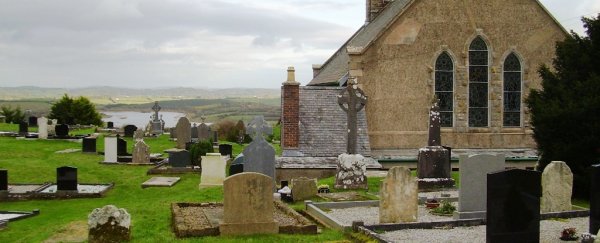Faced with the rising threat of drug resistant pathogens, researchers are all but giving up hope that new treatments can be easily cooked up in the lab.
One recent discovery gives us hope that novel antibiotics are easier to find than we think, perhaps in plain sight right under our very feet. And it's possible their curative properties could have already been recognised centuries in the past.
An international team of researchers based at Swansea University Medical School in South West Wales recently identified a new strain of bacterium in 'healing soil' taken from a site associated with ancient druidic rituals in Northern Ireland.
The find belongs to the genus Streptomyces, already well known for being a microscopic drug factory that has contributed a diverse array of pharmaceuticals.
Streptomyces sp. myrophorea, as it's been dubbed, has already demonstrated a talent for impeding the growth of some of the nastiest bugs around, and contains a variety of gene clusters associated with a veritable arsenal of microbial shields and weapons.
"This new strain of bacteria is effective against four of the top six pathogens that are resistant to antibiotics, including MRSA [methicillin-resistant Staphylococcus aureus]," says molecular biologist Paul Dyson.
Surprisingly, the strain not only inhibits the growth of the stiff-walled gram positives, it does a good job against many of the harder to kill gram negative bacteria as well.
The exact compounds responsible are yet to be identified and purified, let alone clinically tested.
What we do know so far is that it came from a particularly alkaline patch of soil in Northern Ireland that's long been associated with healing uses.
Places like thermal vents and high pH soils are known to be hot-spots of battling bugs, making them a good place to hunt out strange new types of microbes.
The patch of earth is found in the grounds of the Sacred Heart church in Ireland's Boho (don't pronounce the 'ho' part) Highlands, also known as Fermanagh.
According to the researchers, there are whispers of the area's soil being used by druids to treat a variety of infections, including toothache back in the day.
Soil is said to have been wrapped in a cloth and placed against the infection for nine days before being returned to the site it was taken.
Before jumping to conclusions on the wisdom of the ancients, the same rumours also claim the soil can be placed under the pillow.
There also isn't a whole lot of evidence out there supporting this practice, with the researchers noting that the "exact specificity and origins of the cure are obscured by lack of documentation."
Take from it what you will.
But even if the actual links are tenuous, there is still an important lesson to be learned here.
"Our results show that folklore and traditional medicines are worth investigating in the search for new antibiotics," says Dyson.
"Scientists, historians and archaeologists can all have something to contribute to this task."
In today's ultra-clean world, soil isn't quite what comes to mind when we think of prime sources of pharmaceuticals. Yet geophagy – the consumption of minerals – and the use of earth in medicine isn't as uncommon as you might think.
The death toll from antibiotic resistance is rising, with some of the more alarming predictions putting the numbers in the millions by 2050.
We desperately need new alternatives to antibiotics. And turning to other cultures for signs of where to start digging for new soil-based antibiotics is as good a place to start as any.
This research was published in Frontiers in Microbiology.
